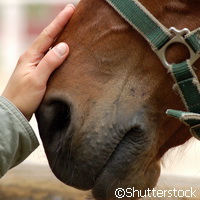Researchers solve horse domestication mystery
Researchers in Georgia and Russia have shed new light on the history of the domestic horse, finally piecing together a puzzle that has perplexed scientists for years. They found that domestic horses originated in the steppes of modern-day Ukraine, south-west Russia and west Kazakhstan. They also discovered that domestic horses mixed with local wild stocks as they spread throughout Europe and Asia. Their research, published in the journal PNAS, puts to rest questions about multiple domestication events across a wide expanse on Earth. Scientists have always wondered about how horses became domesticated. While archaeological evidence compelled many to lean towards the theory that horse domestication originated in the western part of the Eurasian Steppe, others thought that a single origin in a geographically restricted area was at odds with the extensive number of female lineages in the domestic horse gene pool. Led by the University of Cambridge in the United Kingdom, researchers from Georgia, Kazakhstan, Russia and the United States used a genetic database of over 300 horses sample from across the Eurasian Steppe to run various modelling scenarios. Their data indicate that the extinct wild ancestor of domestic horses, Equus ferus, expanded out of East Asia around 160 000 years ago and was domesticated in the western Eurasian Steppe. The results also point to herds being repeatedly restocked with wild horses as they made their way across Eurasia. 'Our research clearly shows that the original founder population of domestic horses was established in the western Eurasian Steppe, an area where the earliest archaeological evidence for domesticated horses has been found,' said Dr Vera Warmuth from the Department of Zoology at the University of Cambridge. 'The spread of horse domestication differed from that of many other domestic animal species, in that spreading herds were augmented with local wild horses on an unprecedented scale. If these restocking events involved mainly wild mares, we can explain the large number of female lineages in the domestic horse gene pool without having to invoke multiple domestication origins.' Thanks to their study, the researchers offer the world the first-ever genetic proof of a geographically restricted domestication origin in the Eurasian Steppe, confirming what archaeological finds have long suggested. Their results also confirm that the female diversity was triggered by the later introductions of local wild mares into domestic herds. The authors write: 'Our best-fitting scenario further suggests that horse domestication originated in the western part of the Eurasian steppe and that domestic herds were repeatedly restocked with local wild horses as they spread out of this area. By showing that horse domestication was initiated in the western Eurasian steppe and that the spread of domestic herds across Eurasia involved extensive introgression from the wild, the scenario of horse domestication proposed here unites evidence from archaeology, mitochondrial deoxyribonucleic acid (DNA), and Y-chromosomal DNA.'For more information, please visit: University of Cambridge: http://www.cam.ac.uk/(opens in new window) PNAS: http://www.pnas.org/(opens in new window)
Countries
Georgia, Kazakhstan, Russia, United Kingdom



